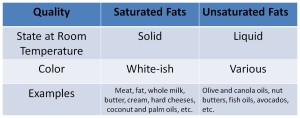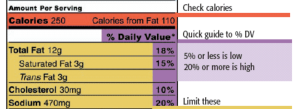What is FAT?
Dietary fats are composed of a triacylglycerols, which are a glycerol molecule backbone with chains of carbon atoms called fatty acids attached. Once digested, fat serves to protect body organs, absorb some vitamins, and provide energy during aerobic exercise. One gram of fat provides nine calories of energy. It is recommended that fats make up 20-35% of one’s diet.
I can eat fat?!
YES! Like protein, there are certain fats that the body does not produce enough of on its own; conscious intake is required. Two of these essential fats that you may have heard of are omega-3 and omega-6. These fats can be found in vegetable, seed, nut, and fish oils. Most Americans get a sufficient amount of omega-6, and should look to increase their intake of omega-3 up to 1.5 grams/day.
Fat has a bad reputation:
Fat tends to be equated with gaining more mass. However, as has been noted, fat is an essential part of our diets! So why does some fat intake lead to obesity, and other fat intake lead to health? One word: SATURATION. There are “good,” unsaturated fats, and “bad,” saturated fats. The saturation of a fat is indicative of how many double bonds are between carbon atoms on the fatty acid chain, but here are some ways to identify them more readily:
So…what should I be eating?
Even though saturated fats are considered “bad,” they should make up about 1/3 of total fat intake depending on how active someone is. If 30% of an athlete’s diet is fat, then 10% of that should be saturated, and 20% unsaturated. Checking nutrition labels can be a helpful way to track this (see Figure 1).
First, an athlete must check to make sure that the number of calories from fat is 1/3 or less of the total calories of food (highlighted in red). Then look down to the section indicating total, saturated, and trans fat. Be sure that the saturated fat is less than or equal to 1/3 of the total fat (highlighted in yellow), and that the percent daily value of each is between 5-20% (highlighted in purple).
Figure 1: Nutrition Label
Depending on your sport, different fat intakes are recommended. In high power sports, like sprinting or power lifting, diets high in fat have been found to reduce performance. It may be wiser to stick to the lower end of the recommendation (20% of intake). For athletes participating in prolonged submaximal exertion (typically distance runners, athletes in sports that require low-moderate intensity exertion), going with the higher end of the recommended fat intake (35%) can improve performance because fat is metabolized for energy during aerobic exercise (lower intensity, longer duration). The most important thing to keep in mind is to consume what you use! Any calories that are not utilized will be stored in the cells, causing them to expand or make more, which leads to weight gain.
As with all caloric intake, the exact number of calories is dependent on the individual (height, weight, sex, activity level, other genetic factors). A nutritionist should be consulted for specific needs, diet plans, and other recommendations.
Erin Blaser BA (University of North Carolina Chapel Hill ’15 NASM-CPT)


